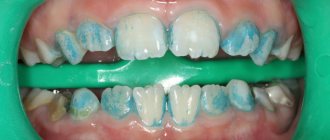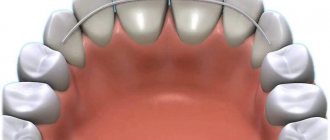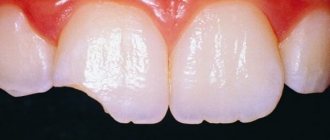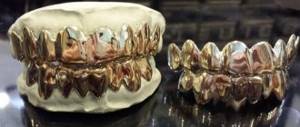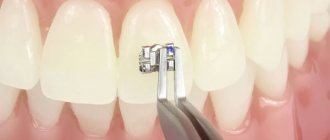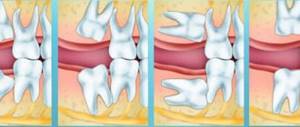Coated tongue
Light white
Such tongue indicates problems with the liver or gastrointestinal tract. Since it is impossible to establish an accurate diagnosis based on this symptom alone (it could be either low acidity or a stomach ulcer), it is better to consult a doctor.
Thick layer of white plaque
If your tongue is covered with a thick layer of white coating, this is not a good sign that some systems in the body cannot fully perform their physiological functions in maintaining health. It may also indicate the presence of a viral infection.
Yellow
This type of plaque indicates liver or gallbladder disease. It can also be a sign of stagnation of food in the body and poor digestion.
Unevenly colored, grooved tongue
“Geographical” tongue is a sure sign of gastrointestinal diseases. If the grooves are so deep that they look like cracks, this indicates increased blood sugar. A doctor will help you establish an accurate diagnosis.
Treatment
If after a couple of days the symptoms have not disappeared or, on the contrary, have intensified, rush to the dentist
If the papillae are inflamed, but the cause is difficult to determine, then first of all, rinse your mouth with an antiseptic solution.
If after a couple of days the symptoms do not disappear or, on the contrary, intensify, rush to the dentist.
After conducting the diagnostics, he will make a diagnosis and either refer you to another doctor or describe how to treat the problem.
Typically, treatment consists of antiviral (acyclavir, Zovirax) and antihistamine (suprastin, tavegil) drugs, antibiotics (clorsacillin, clindomycin) and antifungal agents (chlorhexidine, furacelin, miramistin).
If you can’t see a doctor, you can improve your condition at home.
The following methods are effectively used for this:
- You can apply ice (or chew it) to relieve swelling.
- Regularly rinse your mouth with a baking soda solution (15 grams of baking soda per 1 glass of lukewarm water) - this will help relieve inflammation and reduce swelling.
- Lubricate the problem area with honey - this product is famous for its antibacterial properties, and it will also help relieve swelling and promote tissue regeneration.
- Drink natural yogurt - it will help restore normal oral microflora if the problem lies in its disturbances.
Tongue color
Pale white tongue
A white or pale tongue is most likely a sign of problems related to the digestive system. This color of the organ is often accompanied by loose stools, cold hands or feet, fatigue or bloating.
An extremely pale, dry tongue may also indicate a blood deficiency, which is usually accompanied by anxiety, dizziness, memory loss, insomnia, chapped lips or anemia.
Red tongue
A bright red tongue almost always indicates an infection in the body. Red dots on the tongue may indicate temperature or inflammation in the blood. Children may develop an immune response to infection in this way. Dark red color is a sign of kidney problems or intoxication of the body.
Red tipped tongue
The tip of the tongue is also known as the heart area. Given this fact, a red tip of the tongue without any signs of illness may indicate emotional turmoil.
Tongue, red around the edges
This color of the tongue indicates excessive consumption of spicy or fatty foods, as well as alcohol. According to Eastern medicine, the result of long-standing anger or resentment can manifest itself in the same way.
Purple tongue
Most often, this color is caused by a deficiency of vitamin B2. It can also occur in women who have very difficult menstrual cycles or in people experiencing chronic pain.
Blue tongue
If your tongue is blue, this is a signal to urgently consult a doctor. It indicates that insufficient oxygen is reaching the tissues. It may also be a sign of developing heart disease, damaged blood vessels, or dysfunction of the heart or respiratory tract.
Yellow tongue
If the yellowness of the tongue does not go away for a long time, then it is a sign of liver or gall bladder disease. The front part of the tongue is yellow - a sure sign of hepatitis.
Features of child treatment
Even with papillitis, you can catch a serious complication
If a child complains of pain in the tongue, and you notice redness of the papillae, brush the baby’s teeth, ask him to rinse his mouth thoroughly, and go to the dentist.
The child’s immune system is not yet strong enough to cope with inflammation on its own.
Even with papillitis, you can catch a serious complication, since a curious child explores most objects from the surrounding world using the oral cavity.
Yagya Katuval
Nepali Yagya Katuwal is also an ambitious person who wants to become famous throughout the world. His unique capabilities, namely the unusual structure of the lower jaw and long tongue, allowed him to claim a place in the Book of Records.
Katuval grimaces with all his might, using the features of his body: licks his forehead, covers his nose with his lower lip, etc. The man also has only one tooth, which adds even more curiosity to his image.
Yagya works as a school bus driver, often horrifying little passengers. Even adults sometimes shy away from an eccentric man. Katuvala is no longer upset by this; on the contrary, he dreams of starring in a horror film and getting into a big movie.
External manifestations
In normal condition, the human tongue is clean and moist, with symmetrical edges and a uniform surface. As the disease progresses, these parameters change.
Depending on the pathology, the surface may become dry and glossy . The organ takes on an unhealthy pigmented hue . There is an upward change in size.
When the tongue protrudes, its deviation from the midline is noted. In some cases, pain and a pronounced change in surface relief occur. The epithelium may become covered with cracks and ulcers.
Possible pathologies of the organ itself
However, diseases of the tongue itself are the most common cause of its modification. Each of them has its own causes of development and characteristics of clinical manifestation.
Acute inflammatory diseases (glossitis)
Acute inflammatory pathologies are characterized by rapid development with rapid manifestation of symptoms. Let's look at several main types of glossitis.
Catarrhal
It is provoked by infectious pathogens that damage the epithelial layer. The main negative role is played by staphylococci and streptococci .
Most often, glossitis occurs as a result of digestive dysfunction, a severe allergic reaction and the presence of chronic pathologies.
In some cases, acute inflammation begins with regular injury from a chipped tooth or a poor-quality denture.
The initial symptom is severe burning or soreness of the tongue. Swelling of the lateral surfaces gradually develops, on which tooth imprints remain.
Two days after the onset of the pathological process, a limited focus of dense white plaque forms in the area of the back of the tongue. The papillae increase in size, and the sense of taste atrophies.
The disease can last from 1 week to 2 months .
Mycotic
This type of glossitis occurs as a result of a fungal infection that affects the ENT organs : tonsillitis, pharyngitis.
The pathology is characterized by a strong enlargement of the tongue, in which its surface is covered with multiple grooves. Against their background, whitish spots are formed, surrounded by a smooth hyperemic surface.
As glossitis develops, the spots increase in size and cover the entire surface of the organ.
Ulcerative
It is a consequence of timely untreated catarrhal glossitis . It can also develop with diseases of the gums and oral mucosa.
The ulcerative form is manifested by slight swelling of the tongue, on which numerous aphthae form. They are covered with a white coating consisting of dead epithelium.
When it is removed, a bleeding surface is exposed, painful when exposed.
At the same time, there is a deterioration in the patient’s general condition with fever, weakness, and headache. At the same time, the condition will depend on the number of manifestations: the more there are, the more pronounced the symptoms of intoxication and the longer the process of inflammation.
Desquamative
It is an inflammation manifested in the form of a furrowed tongue . Because of this, the disease has received the additional name “geographical” tongue.
In some cases, there is a change in the position of the grooves, which occurs in just 3 days. Its surface has a pink color, against which unnatural red spots stand out, surrounded by white ridges. In some places, focal desquamation of the papillae is observed.
Desquamative glossitis develops as a result of the development of exudative diathesis, diseases of the gastrointestinal tract, and metabolic disorders .
Chronic diseases
Chronic inflammation of the tongue is much less common than the acute form of the disease . Chronic pathologies most often have smoothed symptoms and rarely cause inconvenience .
Folded glossitis
The cause of its development is considered to be a gene abnormality . Language changes are observed from birth. The main symptom of glossitis is the presence of many sweet spots of varying depth. At the same time, the epithelium has a healthy shade.
A deterioration of the situation can be observed with severe vitamin deficiency. Against the background of a lack of vitamins, keratinization of the surface layer develops, which becomes dry.
Painful, difficult-to-heal cracks form in the folds and bleed under mechanical stress.
Hairy black tongue
The pathology received its name because of a characteristic feature: a dark area with elongated papillae appears in the posterior region of the tongue, which reach 2 cm in length. The black color is explained by the keratinization of the papillae, which begin to darken as they die.
The degree of development of the pathology can be determined by the shade of the affected area. Lengthening of the papillae is accompanied by soreness and dryness of the oral mucosa. Also, patients note a constant sensation of cotton wool in the mouth.
The causes of this disease are still not fully understood. The main theory that doctors adhere to is a metabolic disorder as a result of a genetic mutation, medication or chronic diseases of internal organs .
Diamond-shaped medial glossitis
Develops as a result of disruption of the gastrointestinal tract . The disease is characterized by the appearance of a hyperemic area with thickened epithelium in the basal region of the tongue.
As it grows, the area acquires a bluish tint and rises above the healthy tissues of the organ. In appearance, the affected area resembles a tubercle.
If treatment is not carried out at this stage, the inflamed area will continue to enlarge, after which it will take on a papilloma-like shape.
Glossalgia
It develops against the background of serious dysfunction of internal organs or regular injury to the soft tissues of the oral cavity. Most often occurs in older people.
Glossalgia passes without visible changes in the mucous membrane. The patient notes itching, burning or tingling that develops due to dryness of the epithelium. These symptoms manifest themselves especially strongly at times of excitement.
In rare cases, there is pain localized in one place of the tongue, which quickly passes. In advanced cases, plaque appears on the entire surface of the organ, white or gray in color.
Leukoplakia
It is a pathology that develops as a result of metabolic disorders and gastrointestinal dysfunction . It is most often diagnosed in men aged 30 to 40 years.
The main signs of leukoplakia include white plaques covering not only the surface of the tongue, but also the mucous membrane of the cheeks, as well as the corners of the mouth. Their formation continues for several weeks. In the process of enlargement, the inflamed epithelium becomes compacted and thickened.
Due to this, the formed plaques rise above the healthy tissue.
Leukoplakia occurs without pain. Slight discomfort may be experienced when consuming hot or spicy foods that irritate the inflamed epithelium.
The main danger of the disease is its malignancy. In 30% of cases, malignant degeneration of the pathology was observed.
Infectious diseases
Pathological changes in the tongue can also cause infectious diseases, which include:
Candidiasis
It mainly occurs in children, but can also affect adults, mainly the elderly.
The reason in this case will be a decrease in immunity or the use of incorrectly installed prostheses . Increasingly, the cause is self-medication with medications that destroy the microflora of the mucous membrane .
Candidiasis is identified by the formation of a characteristic plaque localized on the surface of the tongue, mucous membranes of the lips and cheeks, in the form of small limited areas. The disease begins with slight redness of the mucous membrane, on which small white rashes, reminiscent of semolina, gradually begin to appear.
As pathogenic microflora spread, they increase in size, covering more and more of the mucosa and gradually merging with each other. The white coating can be easily removed. A bleeding, painful epithelium is found underneath.
The pain intensifies while eating.
Herpetic glossitis
Occurs due to infection with the herpes virus . It is characterized by multiple rashes of small transparent blisters filled with serous fluid.
The rash is accompanied by a strong increase in body temperature. The blisters are very itchy and give off a burning sensation upon any impact. At the site of their opening, deep bleeding erosions are formed, characterized by pain.
The pathology can last from 3 days to 2 weeks .
Impetigo streptococcal
Appears during a period of decreased immunity, deterioration in the quality of oral care or taking medications .
Impetigo begins with the formation of a small red spot on the surface of the mucosa. Within a couple of hours, a small bubble with transparent contents appears at the spot.
As impetigo develops, the fluid in the vesicle becomes cloudy, it becomes flabby and breaks open, leaving behind an ulcer. The ulcer heals within 3 weeks . A small lump remains in its place, which resolves within a week.
Nick Afanasiev
A Russian emigrant, now living in the United States, decided to announce himself to the world and become famous. So, he discovered that the length of his tongue was 8.9 centimeters .
This feature could help him gain fame, especially since Nick Afanasyev dreamed of becoming a popular actor. The ability to reach his nose and elbow gained fame for the guy when he posted a video online. Then the views reached more than a million, and the guy began to receive long-awaited invitations to auditions.
Thus, the unusual young man starred in the teen series iCarly, and now his filmography has exceeded 10 projects. It turns out that not only speakers and singers can make money with a language.
Prevention
Prevention of these diseases includes several rules :
- It is necessary to provide high-quality dental care and visit the dentist in a timely manner for routine examinations and elimination of emerging problems.
- Pathologies of internal organs must be treated at the initial stages, preventing them from becoming chronic.
- You need to quit bad habits and balance your diet.
These simple rules will help you avoid inflammation of the tongue and at the same time maintain the health of the body.
If you find an error, please select a piece of text and press Ctrl+Enter.
Tags diagnostics treatment symptoms language
Did you like the article? stay tuned
Previous article
Ulcerative necrotizing gingivitis: how does it manifest itself, why is it dangerous?
Next article
What opportunities does the use of Impro implants provide?
Annika Irmler
Now Annika Irmler's , a tongue 7 centimeters long, has long been broken, but back in 2001 it was an undoubted leader. During the competition, it was necessary to pull the muscle out of the mouth as far as possible, which was achieved by a 12-year-old girl.
Of course, this feature gained Annika fame and popularity at school. And even before that, as a child, she demonstrated an unusual organ to everyone who asked.
Nick Stoberl
The young man defeated the previous record holder four years ago - the length of his tongue was just over 10 centimeters . The record holder comes from America, where he works part-time as a comedian and artist.
He optimistically and cheerfully demonstrates the peculiarity of his body to everyone, takes pictures with fans and maintains personal pages on social networks. The guy is glad that he can amuse his friends and fans with his tricks. Nick Stoberl admits that his father also had an unusually long tongue, meaning the phenomenon was inherited.
The guy said that it was not easy to officially register his record, since his ambitions coincided with the 60th anniversary of the existence of the Book of Records. So, before the anniversary edition, all record holders were checked very meticulously, but the guy was able to get into it, which he is very proud of.
Anatomy and functions
The human tongue by its nature is a muscular organ that does not have bones. On top it is covered with a mucous membrane. Tasks and functions it performs:
- participates in the functioning of the speech apparatus;
- determines the taste of the food a person eats;
- is part of the digestive system - it performs primary processing of food, mixes it and forms a food bolus, which pushes further into the esophagus.
The structure of the language is simple but interesting. This organ is divided into two parts - the back - the root and the front - the body. The upper surface is also called the back and has a velvety structure.
The tongue is covered with papillae, which are divided into 4 groups responsible for recognizing tastes. That is why, with a burn or other injuries to the tongue, a person temporarily loses the ability to perceive one or more tastes.
Adrianna Lewis
Young Adrianna's tongue is one of the longest among girls - more than 10 centimeters . She did not hesitate to publish a video online showing off her unusual organ in all its glory. The video collected hundreds of thousands of views, and the girl gained curious fans.
In structure, Adrianna Lewis's resembles a snake - nimble and quick, capable of reaching the elbow, contrary to proverbs. A girl can also lick the tip of her nose and even reach her eyes with her tongue. After active negotiations with representatives of the Book of Records, the girl was able to record her record.
Andrianna's peculiarity was noticed by her mother when she was still 12 years old and actively ate ice cream. Adrianna enjoys taking pictures, showing off her muscles, and runs her own YouTube channel, where she posts funny tricks.

